Don't wanna be here? Send us removal request.
Text
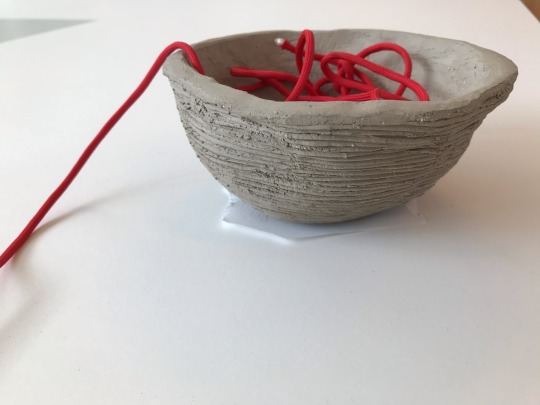

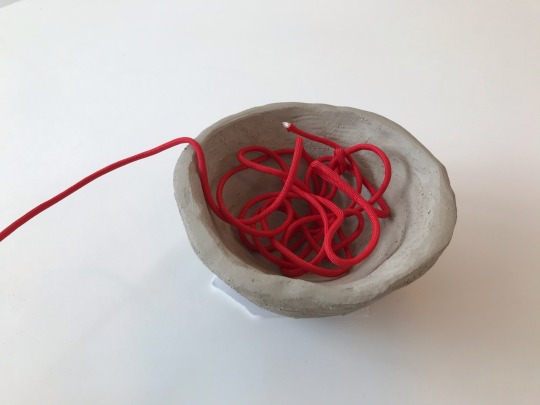
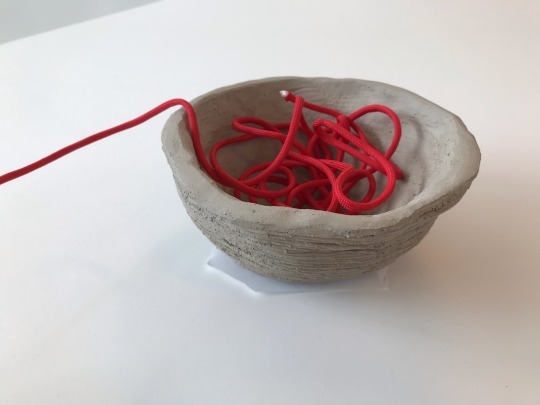
This is the final product. I added the red rope, to symbolise knowledge going from genre ration to generation. I used red to symbolise the blood spilled in the past.
0 notes
Text

I changed techniques, I used a small V limo took but instead of carving out I turned it over and scraped it around the bowl. I really really like this effect it looks like scarring from whips. I’m super proud of this, it’s the effect I wanted too.
0 notes
Text
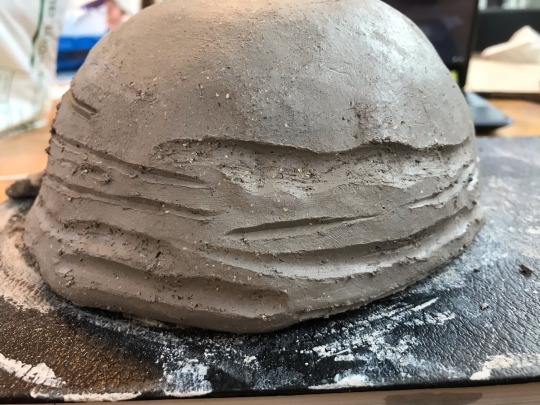
I started making these marks with a large U Lino tool but I’m not like omg the effect. I want the outside to look like whipping scars but It’s looking more like bark than scars. I might try a small V lino tool.
0 notes
Text
Sheila Hicks
Hicks began working with fibers in the late 1950s, traveling from Chile to Morocco to India to study the weaving techniques of local artisans. Rather than making flat works, Hicks built on her research by pushing the medium into three dimensions, producing tactile objects that entice viewers to reach out and touch them. “I think that is important, the wanting: the desire to hold it in your hands, to befriend it, to see if it bites,” the artist has said. For her site-specific work Séance at Design Miami/ Basel in 2014, Hicks presented bundles of brightly colored fabrics, which appeared like giant heaps of cotton candy in the darkened room. While she is best known for such large-scale works, she has also been a prolific maker of miniature textiles. Using a handloom, she incorporates unexpected materials like porcupine quills, feathers, steel fibers, and bamboo into small abstract compositions, which the artist playfully calls her “minimes.”
I love this, i love the flowing of the fibers going down to the puddled lump at the end. reminds me of a waterfall making me feel calm and serene. She uses multiple colours and has them starting at slightly different heights to make the top not look to bulky

0 notes
Text
Richard Serra

The artist Richard Serra has spent most of his career examining the subject of humanity’s metaphysical bond with physical space. He’s a multi-disciplinary artist, having worked with painting, drawing, video, performance, writing and dance. But it’s Richard Serra’s sculptural oeuvre that has redefined humanity’s relationship with its surroundings. A welder since childhood, Serra mostly works in steel, creating monumental, site-specific works that don’t simply occupy space, but radically seek to discover its essence.
Serra’s experiences with Gutter Splashes contributed to his interest in the ways that aesthetic objects inhabited space. Depending on how he displayed them, they reorganized the spaces in which they were exhibited, causing viewers to have to move, addressing the physicality of the space, in order to fully consider the art. Informed by this experience, Serra began making what he called “Props,” metal forms exhibited in a way that demonstrated balance. A Prop might involve a metal rod holding a metal sheet flush against a wall with its weight, or a metal sheet leaning against a peg that’s the only thing stopping it from falling, or two metal sheets precariously balancing against each other. Some of Serra’s Props could easily kill a viewer if they were to fall.
i like the way people can experience and interact in the same space as the work, curving and molding with the the sculpture.
0 notes
Text



These bowls were my inspiration from pinterest, The last bowl was my main inspiration for the outside texture. i loved the others but i couldnt think of a way to make the bowl look like a soft shaped rock without it looking terrible and the first one i would break.
0 notes
Text
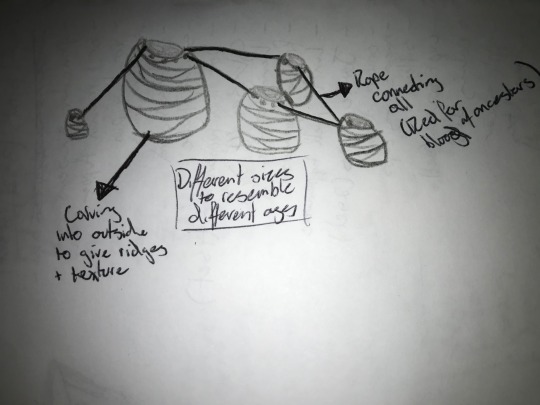
Ive decided to change my idea completely, the body's just weren’t working out. Ive change it to bowls that surround one large bowl and is connected to all the smaller bowls with red rope. The carvings i want to make ridges to make it look like whip scars to represent the abuse that Indigenous Australians went through during the first settlement and later.
0 notes
Text
Anish Kapoor

The works include mirror pieces, in which pairs of the artist’s immaculate concave surfaces are brought together for the first time in corners of the gallery, while others curl up into the form of lipped openings reflecting red highlights onto the sculpture. Lying astride two different rooms, a large floor-standing sculpture, made of exposed welded metal and fibreglass, looks in turn like a munition, decaying felled tree trunk and phallus. A silicone work is set against a wall —in the artist’s words, “an ooze of the semi-described.”
I find these works a little unsettling, this work looks like the the fuzzy outside is trying to overtake and kill the large oyster looking centre.
0 notes
Text
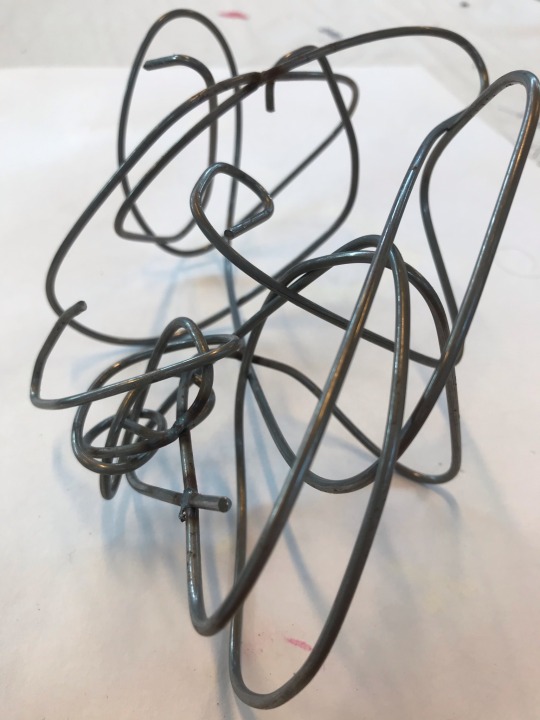
Started experimenting with making the bodies. I’m not liking my idea, I can’t make the bodies with the illuminum wire because it’s too soft to hold the heavy heads the thick wire is hard to get the thick depth through the body that I want. I might change my idea, I was thinking about bowls flowing into the other.
0 notes
Text
The Yeperenye (Ayepe-arenye) caterpillar is the most important of the three caterpillars that are major creative ancestors of Alice Springs. The sculpture of Yeperenye is located in the Cultural Precinct of Alice Springs and presents a dreaming story of the Macdonnell Ranges.On entering the three metre high Yeperenye sculpture, visitors find information and artworks detailing the caterpillars habitat, life cycle and cultural significance. The sculpture was developed by metal artist, Dan Murphy working with students from the Centre for Appropriate Technology's ATWork program. Mentoring based workshops with school children and local artists developed one hundred community generated panels to decorate the caterpillar.
This artwork is really interesting, the shapes they are bale to create using sheets of metal is crazy great, the beautiful paintings in the inside make a beautiful work and feature to contrast with the rusted metal.


0 notes
Text
Louise Bourgeois
Spider,1994,steel
Spider is a giant sculpture of an arachnid that stands on the floor. The artwork is made of bronze and granite and was created in 1994 by the French-born American artist Louise Bourgeois. One of the first of many sculptures of spiders made by the artist, Spider measures 2743 x 4572 x 3785 mm, such that it is large enough to occupy the entire space of a room. The body of the spider supports a rounded cage-like structure inside which is held a large white egg. The cage hangs below a cylindrical form, to which are attached eight thin legs stretching out to the floor. Each of the legs is articulated in three sections made of straight rods of bronze, with the exception of one of the legs, where the two sections are bent, creating a semi-circle. The lower parts of seven of the legs end in needle points where the sculpture meets the floor, while the eighth terminates in a small coil. The angularity of the thin legs and their different heights give the impression that the spider is crawling.
This work is really incredible scale wise even though its a creepy spider which would most likely set anyone with arachnophobia into a fit of tears, i love the fact that you can walk underneath and all around the legs of it. great placement and opportunity for installation experience.

0 notes
Text
Research: Nancy Holt
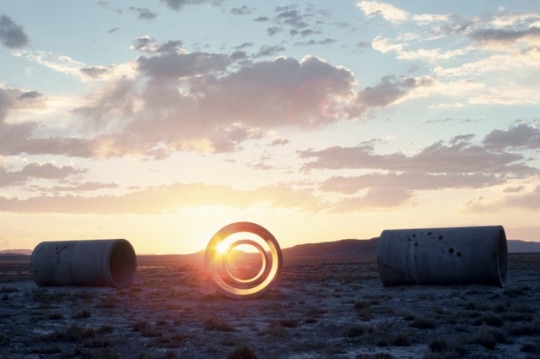
Holt worked with film and photography throughout her career as part of her earthworks as well as to document them. Her final film, however, stemmed from an unfinished work by Smithson. The Making of Amarillo Ramp (2013) included footage of Holt, Serra, and art dealer Tony Shafrazi in 1973 completing Amarillo Ramp, a project that Smithson left unfinished at his death in a plane crash that year. Holts work brings industrial items into nature to form a spiritual connection towards the manmade and the natural products of earch.
0 notes
Text
Research: Robert Smithson
For over fifty years, Robert Smithson's work and ideas have influenced artists and thinkers, building the ground from which contemporary art has grown. Born in New Jersey in 1938, Smithson' early interests in cartography, geology, prehistory, philosophy, science-fiction, and language spiral through his work. From his landmark earthworks to his “quasi-minimalist” sculptures, Nonsites, writings, proposals, collages, drawings, and radical rethinking of landscape, Smithson's ideas are profoundly urgent for our times. His work hits elements of earth art, expressing and highlighting the natural materials properties and the effects it has on the environment its in.
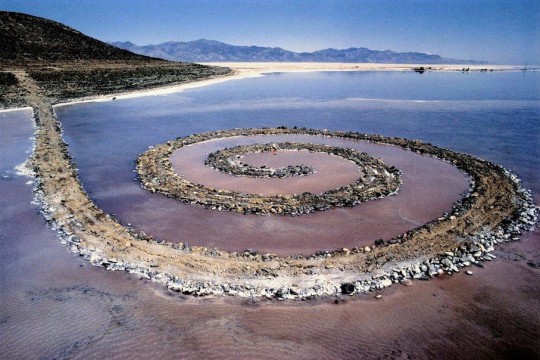
0 notes
Text
Research: Tomás Saraceno
Saraceno’s galaxies piece shows the intricacies and structural strength of line, in his piece the lines extending from the string globes seem to be suspending them into the air, giving the illusion of strong materials instead of soft breakable string that is used in the work. The strong line of the string brings the viewers gaze in, starting from the first tendril they see and slowly following it up to the mass floating within the space. These lines give the illusion of lack of space within the room without the use of chunky and large amounts of materials using such little material allows him to be eco-friendly and cost effective. The large-scale work creates a multitude of small nooks and crannies for viewers to get into to explore different views and advantage points of the work.

0 notes
Text
Week 6:


-focus was on balancing claims
-we tried to make a cluster of bowl like shapes and balance them all on top of each other
-as we balanced each bowl we claimed the spot for it
-we wanted to only use natural materials so we incorporated sand by covering the surface of the clay
0 notes

